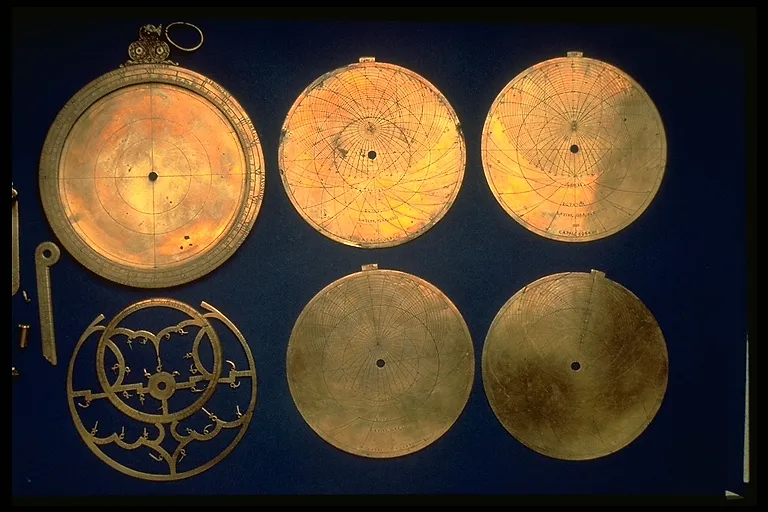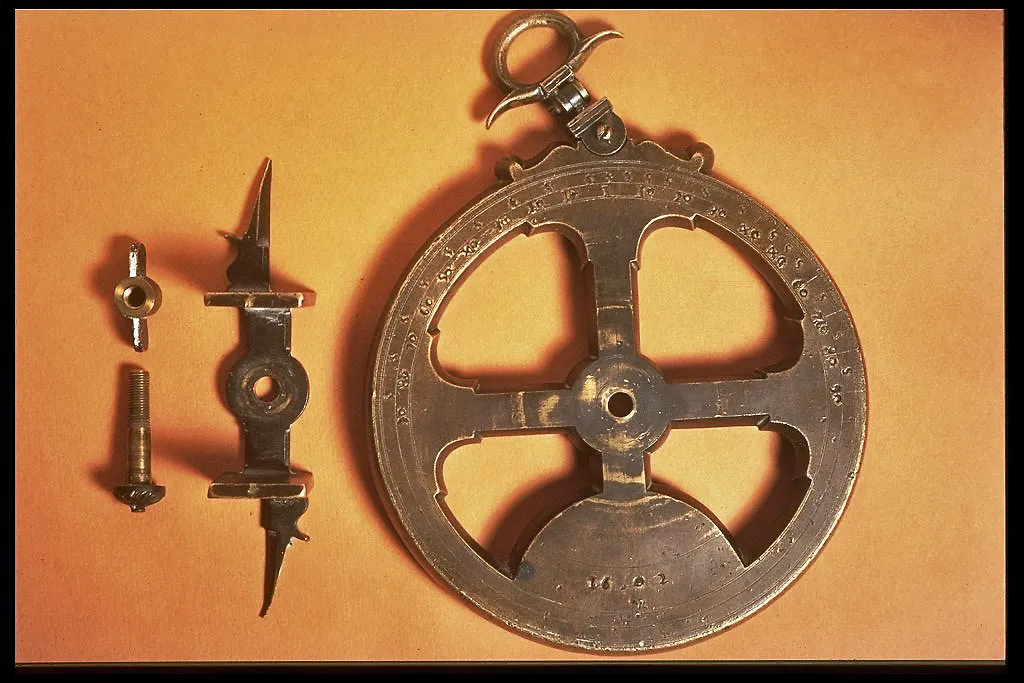The Story of the Astrolabe, the Original Smartphone
Prosperous times likely paved the way for this multifunctional device, conceptual ancestor to the iPhone 7
/https://tf-cmsv2-smithsonianmag-media.s3.amazonaws.com/filer/ee/b8/eeb86a13-d616-4130-b514-fbd728fc4201/planispherical_astrolabe_mg_7100.jpg)
Imagine a device that can do everything: Give you the time, your location, your horoscope, and even help you make decisions—all with the swipe of a hand. It’s overpriced, customizable and comes with a variety of bells and whistles. No, this isn’t the iPhone 7. It’s the astrolabe, a remarkably versatile tool that was used for centuries in European and Islamic cultures before being quietly overshadowed by newer technologies.
Like the smartphone, the astrolabe came into being during times of economic prosperity—in that case, likely during the height of the Roman Empire—and remained popular through the 18th century. Today, this somewhat-scientific, somewhat-mystical device leaves its traces in modern analog gadgets like a slide rule or the fanciest Swiss watches.
And while it’s no longer common for the educated elite to have one of these frisbee-sized objects hanging from their wall, some still do have these powerful tools lying around today. One is Owen Gingerich, a professor emeritus of astronomy and the history of science at Harvard University. He first became interested in astrolabes when a student presented one to him in his office years ago, offering to sell this family treasure in order to help fund a medical clinic back home in Afghanistan.
“I expressed an interest in it because I knew there was such a thing but I had never really handled one before,” says Gingerich. When the student offered to sell it, Gingerich obliged, with plans to use it as a teaching tool. “When I began to learn more about astrolabes, I realized I had a tremendous bargain and I sent him another check. This got me going on them.”
The astrolabe, which translates roughly to “star-taker” in Greek, traveled out of Europe and into the Islamic world by the 8th century. While devices from different regions and time periods could vary widely—depending on their intended purpose and who made them, they could be as small as a coffee saucer or as large as a trash can lid, and made out of anything from wood to brass—they shared a similar structure.
In general, these multi-use tools consist of a circular stack of sliding features all embedded within a disk called a “mater”. A round plate containing a two-dimensional projection of the Earth’s latitudinal lines sits within the mater and, over that plate, another circular feature called the “rete” contains the locations of certain well-known stars in the sky. Over that, a straight rule pivots around to line up with time measurements along the edge of the mater. And on the back of the whole thing, a pivotable siting device helps find the altitude of a star—often the starting point of a calculation.

Because the geography of the sky changes with your latitude, astrolabes commonly came with a series of plates associated with different latitudes of large cities. And though they could have been made out of a variety of materials, the majority that remain intact today are made of brass, very ornate, and are often associated with the educated elite, says Gingerich.
“They were kind of like your dentist’s diploma,” says Gingerich. “Something to put up on the wall to guarantee that you are a specialist and know how to use these things.”
Still, while very fancy astrolabes remain today, there were likely plenty of others created for more ordinary people that have since rotten away if made of wood or gotten thrown back into the melting pot if they were made of metal, says Alexander Jones, a researcher at New York University and an expert in ancient astronomy.
“For every fancy one, there were probably many more that were functional but didn’t have the elaborate metalwork, and did the job people needed,” Jones says.
That job took many forms. Astrolabes had blended uses, from scientific to what we would today consider spiritual. They have a strong history in Islam as a tool to find both the direction of prayer toward Mecca—known as the Qibla—as well as the five times of prayer required throughout the day, as stated in the Quran. They later became popular amongst Europeans during the Middle Ages as an astrological tool to make decisions ranging from when to go to battle to how to go about bank dealings. These decisions were often based on the zodiac that was rising at the time of your birth, says Jones.
It’s difficult to know who first invented the astrolabe, since writings about the earliest astrolabes were likely recorded on papyrus that has decayed, says Jones. But there is strong evidence that the astrolabe got its start around the time of Claudius Ptolemy, a famous Greek astronomer who lived in the Roman Empire during the 2nd century AD. Ptolemy left records suggesting he used a three-dimensional instrument similar to the astrolabe to make calculations, says Jones.
The mere fact that Ptolemy was doing this type of advanced work was possible largely thanks to the prosperity of the Roman Empire at the time, Jones says.
“Science in those days was mostly done by individuals who were well off and who were doing things because they were just interested in them,” he says. “At times when the empire was in turmoil, with emperors being assassinated every second year and with an economy that is in a complete mess, it’s not surprising that these are times when intellectual activity seems to be at a lull.”Similarly, the first smartphones hit the scene in the U.S. during the economic boom of the 1990s and early 2000s.
With this reasoning, Jones places the invention of the astrolabe either during the time of Ptolemy or during the 4th or 5th century, after the hard times that the Roman Empire faced during the 3rd century.

While the astrolabe may strike some of today’s scientists as primitive, even its less-scientific components helped inspire modern techniques. From the invention of the astrolabe came new methods of mathematics, along with the early development of astronomy, says John Huth, a physicist at Harvard University. In fact, Huth says that astronomy and astrology developed hand-in-hand during this time.
“If you look at these almanacs of the stars, in some sense they offered ways of predicting where the planets were going to be, but they were also giving information to astrologers,” says Huth. “This is one of the things that drove the development of astronomy, getting higher precision in astrological predictions.”
The astrolabe also made its ways into other ancillary fields of science, including meteorology. Without satellites or radar providing minute-by-minute updates on each impending storm as we get in the 21st century, aspiring meteorologists from Ptolemy’s time through the 1800s often relied on astrology to predict the weather, Huth says.
But Huth’s research interest in astrolabes lies in yet another, perhaps more tangible, application of tool: ancient navigation, the topic of a book he published in 2013. An astrolabe would have been amongst the suite of tools that Christopher Columbus would have used when exploring the New World, for example, along with a quadrant and various tables and almanacs with pertinent information. Portuguese explorers who were accustomed to using the North Star, or Polaris, to find their way also used this tool when they dipped close enough to the equator that Polaris was no longer visible.
“Bartolomeu Dias used the astrolabe to figure out the latitude of the Cape of Good Hope in 1488, because they were so far south that they lost Polaris,” Huth says.
In fact, many of the astrolabes recovered today are found in shipwrecks from Spanish and Portuguese mariners, often found off the west coast of Ireland, says Louise Devoy, curator at the Royal Observatory Greenwich in England, which includes a collection of astrolabes. "It was one of many tools used [on board],” Devoy says, reiterating the idea that an astrolabe would have been amongst a suite of other navigational devices.
But by the 17th and 18th centuries, mechanical clocks were becoming more reliable and affordable. On top of that, new rational approaches to science were developing, and people’s faith in astrology, and therefore their need for astrolabes, began to subside. “There was a new rational sense of thinking, and astrology was not seen as part of that,” Devoy says, referring to the onset of the Age of the Enlightenment.
And so by the 17th and 18th centuries, the astrolabe began to fall out of fashion. Other devices, like modern clocks, sextants for precise navigation, and much later modern computers, took their place. But in the past 20 years, we seem to have revived the concept of the astrolabe in the form of the smartphone, says Devoy.
“It can be used in different locations, it is adaptable and it has a style element, too,” she says of our modern multifunctional tools. Huth agrees: “I can turn my cellphone into an astrolabe quite easily,” he says, before wondering out loud if there is a Qibla app to help Muslims find the direction of Mecca.
A quick Google search during our interview brings up a whole slew of Qibla app options on his screen. “Qibla app for iPhone, there you go,” Huth says as he scrolled through his Google results. “That’s impressive.”